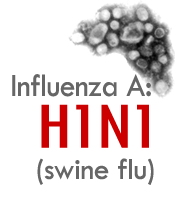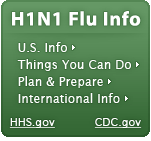HIV
Infection Does Not Appear To Be a Risk Factor for H1N1 Influenza Death, but Vaccine
May Be Advisable
 | So
far there is no indication that people with HIV are at greater risk for complications
or death due to H1N1 influenza (swine flu), according to a global survey published
in the August 20, 2009 issue of Eurosurveillance. |
|
By
Liz Highleyman  First
identified in Mexico in March 2009, the novel
flu strain appears to cause relatively mild illness, and death rates to date
have been moderate. Furthermore, in most countries, the majority of cases of flu-related
complications and deaths have been young people, whereas with a typical seasonal
flu, the elderly are at higher risk. First
identified in Mexico in March 2009, the novel
flu strain appears to cause relatively mild illness, and death rates to date
have been moderate. Furthermore, in most countries, the majority of cases of flu-related
complications and deaths have been young people, whereas with a typical seasonal
flu, the elderly are at higher risk.
In
the present analysis, researchers with the epidemic intelligence team of the French
Institute of Public Health looked at 574 H1N1 flu deaths reported worldwide through
July 16, 2009. Results  | At
least half of the fatal flu cases involved underlying disease. |  | The
chronic conditions most often linked to flu deaths were obesity and diabetes. |  | Pregnant
women also had a disproportionately high rate of flu-related death. |  | A
majority of deaths overall (51%) involved people in the 20-49 age group, though
the age was higher in Canada and Australia. |  | Looking
at a subset of fatal cases with adequate data available: | | |  | 57
involved metabolic conditions such as obesity and/or diabetes; |  | 37
involved respiratory disease; |  | 36
involved heart disease; |  | 19
involved infectious diseases (mostly bacterial infections, including tuberculosis,
Staphylococcus, and Streptococcus). |
|
HIV
infection was not identified as a risk factor. None of the people who died were
reported to have HIV or AIDS, though detailed data were not available for all
cases. A
number of fatal cases did, however, involve people with immune suppression due
to other causes, including cancer, organ transplants, and autoimmune diseases.
This suggests that HIV positive people with heavily compromised immune function
-- a CD4 T-cell count that has fallen to 200 cells/mm3 or lower -- may be at risk. In
August, the CDC's Advisory Committee on Immunization Practices issued a list
of priority groups to receive the H1N1 vaccine when it becomes available.
The list includes:  |
People who live with or care for children younger than 6 months of age. |  | Health
care and emergency services personnel. |  | Persons
between the ages of 6 months and 24 years. |  | People
between the ages of 25 and 64 years who are at higher risk due to chronic health
disorders or compromised immune systems. |
Experts
do not know how the H1N1 flu will evolve over time or how widespread the outbreak
is likely to become during the upcoming northern hemisphere winter flu season.
A vaccine is expected to be available by October. HIV positive people with concerns
about the new flu should consult their healthcare provider. People with symptoms
are advised to stay home and call a doctor, in order to avoid spreading the flu
virus.  The
latest flu information and public health recommendations from the CDC are available
at http://www.cdc.gov/h1n1flu. The
latest flu information and public health recommendations from the CDC are available
at http://www.cdc.gov/h1n1flu.
9/04/09 Reference
L
Vaillant, G La Ruche, A Tarantola, and others. Epidemiology of fatal cases associated
with pandemic H1N1 influenza 2009. Eurosurveillance 14(33). August 20,
2009. (Abstract).
|